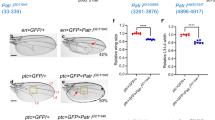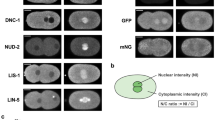Abstract
The metaphase–anaphase transition during mitosis is carefully regulated in order to assure high-fidelity transmission of genetic information to the daughter cells. A surveillance mechanism known as the metaphase checkpoint (or spindle-assembly checkpoint) monitors the attachment of kinetochores to the spindle microtubules, and inhibits anaphase onset until all chromosomes have achieved a proper bipolar orientation on the spindle. Defects in this checkpoint lead to premature anaphase onset, and consequently to greatly increased rates of aneuploidy. Here we show that the Drosophila kinetochore components Rough deal (Rod) and Zeste-White 10 (Zw10) are required for the proper functioning of the metaphase checkpoint in flies. Drosophila cells lacking either ROD or Zw10 exhibit a phenotype that is similar to that of bub1 mutants — they do not arrest in metaphase in response to spindle damage, but instead separate sister chromatids, degrade cyclin B and exit mitosis. These are the first checkpoint components to be identified that do not have obvious homologues in budding yeast.
This is a preview of subscription content, access via your institution
Access options
Subscribe to this journal
Receive 12 print issues and online access
$209.00 per year
only $17.42 per issue
Buy this article
- Purchase on Springer Link
- Instant access to full article PDF
Prices may be subject to local taxes which are calculated during checkout


Similar content being viewed by others
References
Rieder, C. L., Schultz, A., Cole, R. & Sluder, G. J. Cell Biol. 127, 1301–1310 ( 1994).
Amon, A. Curr. Opin. Genet. Dev. 9, 69–75 (1999).
Gorbsky, G. J., Kallio, M., Daum, J. R. & Topper, L. M. Faseb J. 13, S231–S234 ( 1999).
Cohen-Fix, O., Peters, J. M., Kirschner, M. W. & Koshland, D. Genes Dev. 10, 3081–3093 (1996).
Funabiki, H. et al. Nature 381, 438–441 (1996).
Sudakin, V. et al. Mol. Biol. Cell 6, 185– 197 (1995).
King, R. W. et al. Cell 81, 279–288 (1995).
Zachariae, W. & Nasmyth, K. Genes Dev. 13, 2039–2058 (1999).
Clute, P. & Pines, J. Nature Cell Biol. 1, 82–87 (1999).
Taylor, S. S. & McKeon, F. Cell 89, 727–735 (1997).
Taylor, S. S., Ha, E. & McKeon, F. J. Cell Biol. 142, 1– 11 (1998).
Li, Y., Gorbea, C., Mahaffey, D., Rechsteiner, M. & Benezra, R. Proc. Natl Acad. Sci. USA 94, 12431–12436 ( 1997).
Basu, J. et al. Chromosoma 107, 376–385 (1998).
Basu, J. et al. J. Cell Biol. 146, 13– 28 (1999).
Cahill, D. P. et al. Nature 392, 300–303 (1998).
Karess, R. E. & Glover, D. M. J. Cell Biol. 109, 2951–2961 (1989).
Williams, B. C., Karr, T. L., Montgomery, J. M. & Goldberg, M. L. J. Cell Biol. 118, 759– 773 (1992).
Starr, D. A. et al. J Cell Biol 138, 1289– 1301 (1997).
Scaërou, F. et al. J. Cell Sci. 112, 3757– 3768 (1999).
Williams, B. C., Gatti, M. & Goldberg, M. L. J Cell Biol 134, 1127–1140 (1996).
Williams, B. C. & Goldberg, M. L. J. Cell Sci. 107, 785–798 ( 1994).
Scaërou, F. et al. The Zw10 and rough deal gene products are in a large, evolutionarily conserved complex targeted to the leinetochore (submitted) .
Starr, D. A., Williams, B. C., Hays, T. S. & Goldberg, M. L. J. Cell Biol. 142, 763–774 (1998).
Saunders, R. D., Avides, M. C., Howard, T., Gonzalez, C. & Glover, D. M. J. Cell Biol. 137, 881–890 (1997).
Gonzalez, C. et al. J. Cell Sci. 96, 605– 616 (1990).
Gonzalez, C., Sunkel, C. E. & Glover, D. M. Chromosoma 107, 452– 460 (1998).
do Carmo Avides, M. & Glover, D. M. Science 283, 1733–1735 (1999).
Straight, A. F., Marshall, W. F., Sedat, J. W. & Murray, A. W. Science 277, 574– 578 (1997).
Chan, G. K. T., Jablonski, S. A., Starr, D., Goldberg, M. L. & Yen, T. J. Nature Cell Biol. 2, 944–947 ( 2000).
Echeverri, C. J., Paschal, B. M., Vaughan, K. T. & Vallee, R. B. J. Cell Biol. 132, 617– 633 (1996).
Acknowledgements
We thank C. Lehner for anti-cyclin B antibody, C. Gonzalez for the asp mutant, and M.Goldberg and B. Williams for the bub1 mutant, as well as for their encouragement and advice. We also thank F. Scaerou for helpful discussions, suggestions and encouragement. This work was carried out at the UPR 2420 Centre de Génétique Moléculaire of the CNRS, associated with the Université Pierre et Marie Curie, and was supported in part by grants to R.K. from the CNRS and from the Association Pour la Recherche sur le Cancer (France). R.B. was supported by grants BD/11488/97 and P/BIA/111055/1998 from FCT, Portugal.
Author information
Authors and Affiliations
Corresponding author
Rights and permissions
About this article
Cite this article
Basto, R., Gomes, R. & Karess, R. Rough Deal and Zw10 are required for the metaphase checkpoint in Drosophila. Nat Cell Biol 2, 939–943 (2000). https://doi.org/10.1038/35046592
Received:
Revised:
Accepted:
Published:
Issue Date:
DOI: https://doi.org/10.1038/35046592
This article is cited by
-
Dynamics of kinetochore structure and its regulations during mitotic progression
Cellular and Molecular Life Sciences (2020)
-
Zw10 is a spindle assembly checkpoint protein that regulates meiotic maturation in mouse oocytes
Histochemistry and Cell Biology (2019)
-
Spatio-temporally separated cortical flows and spindle geometry establish physical asymmetry in fly neural stem cells
Nature Communications (2017)
-
Transcriptome analysis reveals plant response to colchicine treatment during on chromosome doubling
Scientific Reports (2017)
-
Bub1 positions Mad1 close to KNL1 MELT repeats to promote checkpoint signalling
Nature Communications (2017)



